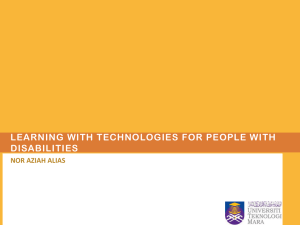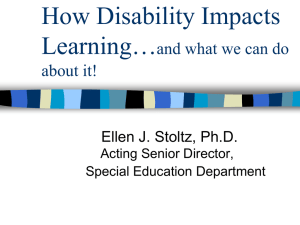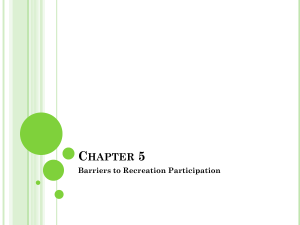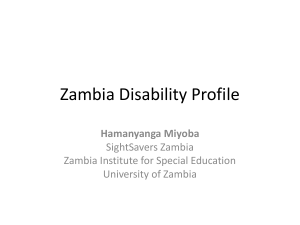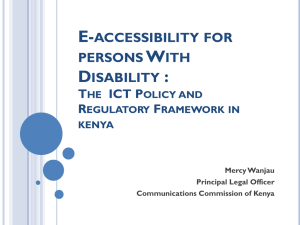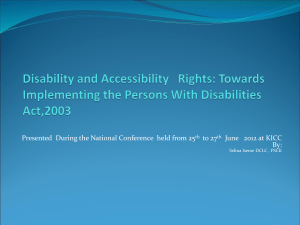FINAL DRAFT ON EAC POLICY ON PERSONS WITH DISABILITIES
advertisement
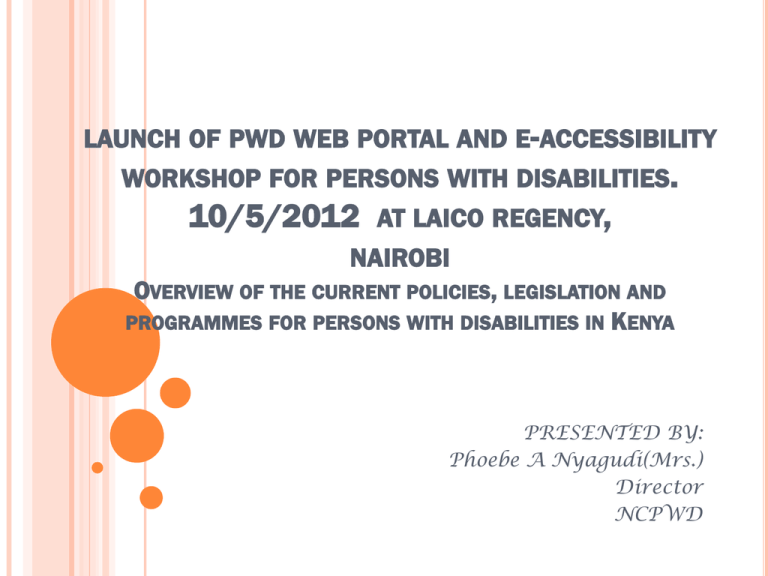
LAUNCH OF PWD WEB PORTAL AND E-ACCESSIBILITY WORKSHOP FOR PERSONS WITH DISABILITIES. 10/5/2012 AT LAICO REGENCY, NAIROBI OVERVIEW OF THE CURRENT POLICIES, LEGISLATION AND PROGRAMMES FOR PERSONS WITH DISABILITIES IN KENYA PRESENTED BY: Phoebe A Nyagudi(Mrs.) Director NCPWD BACKGROUND INFORMATION Recently Kenya inaugurated the African union specialized agency for disability prevention and research in the continent-the east African region office serves 12 countries that include; Uganda, Kenya, Tanzania, Rwanda, Burundi, Sudan, Djibouti, Ethiopia ,the Comoros, Somalia Seychelles and Eritrea. The office provides a unified approach to issues of disabilities in all aspects such as the exchange of information organizing for products in the field of rehabilitation, disability prevention and the analysis of the National Policies and laws for Persons with Disabilities. There are 1.7 million PWDs as per the Kenya National Disability Survey of 2008. The PWDs are disproportionately represented among the poor and tend to be poorer than their counter parts without disabilities. A . LEGISLATION Kenya was the 27th country to ratify the convention on the rights of Persons With Disabilities (CRPD) on the 19th May, 2008: The constitution of Kenya 2010 provides a firm foundation for policy and legislation on disability in accordance with the universal standards for the promotion and protection of fundamental human rights and freedom for Persons with Disabilities The PWDs Act of 2003 was enacted in December, 2003 and came into effect on 16th June, 2004 The Act established the National Council for Persons with Disabilities which is a State Corporations ( Public body )responsible for disability issues. The Act similarly established the National Development Fund for Persons with Disabilities which was operationalised in November, 2009. The Government appoints the Board of Trustees to the National Development Fund for Persons with Disabilities and funds it to channel out financial support to individuals and institutions in accordance to the Persons with Disabilities Act of 2003. CONT . LEGISLATION In addition, the Government endeavor to mainstream issues of disability in National Development; in 2008 it introduced disability mainstreaming indicator for the Public Sector performance contracting guidelines. There are also regulations that provide for the Persons with Disabilities “access compliance” for all buildings in the next five years and for all public vehicles with effect from January 2010. There is the Children’s Act no.8 of 2001 and the Employment Act of 2007 both of which outlaw discrimination against persons with Disabilities. The Sexual offences Act of 2006 extends special protection to Persons with Disabilities B . POLICIES The following policies are currently in place to provide for the wellbeing of Persons with Disabilities; National Strategy for Development, Vision 2010; The National children’s Policy of 2007; National Policy on Special Needs Education of 2007; The National Policy on Ageing and older persons of 2007; and The National Policy on Persons with Disabilities of 2006. C . PROGRAMMES With the creation of a National Development Fund for Persons with Disabilities, the Government availed 2.7m USD to the Fund in FY 2009/2010, which has increased to 7.9m USD in FY 2011/2012 and will continue to increase in the future; There are a number of programmes undertaken by the National Development Fund and these are: Registration of Persons with Disabilities, organizations and institutions Mainstreaming of disability in all private and public sectors of the government CONT. PROGRAMMES Economic empowerment of PWDs by providing Provision of grants to groups Assistive devices Scholarships Infrastructure improvement and Social protection Provision of legal advice and services to persons with disabilities e.g. where they are discriminated or their rights violated Public awareness raising on causes of disability, legislation and treaties and Accounting for all resources received. CONT. PROGRAMMES The Programme on special protection was piloted in 33 districts and targets the elderly persons, including those with disabilities. In addition, the Government has specifically inaugurated a programme for Cash Transfer to Persons with Severe Disabilities in all constituencies irrespective of age; One of the oldest Trust Fund in Kenya established in 1981, the National Fund for the Disabled of Kenya, whose patron is the president, currently receives 0.8m USD annually from the Government to enhance provision of appliances, equipment, economic empowerment and institutional infrastructure for PWDs; CONT. PROGRAMMES Voluntary Testing and Counseling services providers are trained to be sensitive to PWDs; there are 14 National Rehabilitation Centers established throughout the country to provide training to PWDs in vocational skills; and In 1986 Kenya Institute for Special Education for the training of teachers for special needs education was established. D . CHALLENGES There is low awareness and education on disability which results in low attitudinal change; There is limited access to affordable devices and services There is a contrast between the rural and urban PWDs, in terms of access to resources and the standard of living; Women with disabilities have been sidelined from the mainstream women’s movement and as a result services like reproductive health are inaccessible and wanting; The access to free education for all has not been realized by Children with Disabilities because of the disability costs that they face in terms of travel, access to appropriate teaching materials and accessibility of buildings; CONT. CHALLENGES Generally the public transport sector posses a big challenge to PWDs both in towns and rural areas as most of them are privately owned and not disability friendly; The judiciary and the Law enforcement Agencies generally, are insensitive to disability concerns of access to justice; Unemployment is very high amongst the youths with disabilities, whether they are literate or illiterate; and The implementation of the policies and legislation has been found to be very wanting because of lack of representation of PWDs at the formulation stages of education and awareness on disability. E . RECOMMENDATIONS There is need for a coordination mechanism for the implementation of policies and legislation. This will help in the institutionalization and the mainstreaming of disability concerns; The three arms of Government should all be involved in the mainstreaming of PWDs. The emphasis has been on the legislature and executive, but the judiciary has been left out. The courts are inaccessible and the judicial officers are not trained on disability matters and laws; With the existing devolved Government at the counties both human and financial resources should be trickled down in order to provide services to the PWDs in rural areas. CONT. RECOMMENDATIONS Budget allocations and other resources (human/technical) affecting disability are very minimal. Development partners need to integrate the mainstreaming of PWDs as a priority development agenda, to facilitate effective implementation; There should be regular census updated data on PWDs including the categorization of disability ; and There is a need to have disability focal points in strategic positions in all government Ministries and Departments. THANK YOU.





